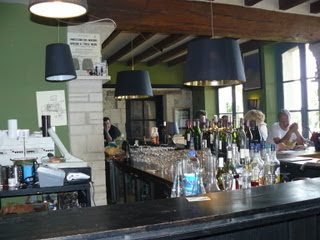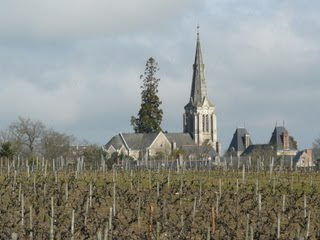Pierre-Jacques Druet had been trying to persuade us to have lunch at this wine/oyster bar in Bourgueil for some time, but things just seemed to keep getting in the way. On Friday however, we had an appointment in Vouvray after lunch and as it was such a lovely Spring day, decided to stop off in Bourgueil on the way.

From the moment we stepped inside, we realised we had been missing out. The atmosphere is completely relaxed and friendly, bottles of wine lined up on the counter, people sitting, drinking, chatting and eating.

Simple, home-made food comes served on traditional ardoise slates - perfect for sharing and great if you love good charcuterie and cheese. We choose a 'grand cochonnaille à partager' (9.90 Euros) which was a selection of home-made charcuterie including 2 different types of terrine, rillauds, andouillete, the best rabbit rillettes we've ever tasted and topped with paper thin shavings of serrano-like ham. A basket of crusty bread comes alongside - quite delicious. To follow, we shared a 'grande fromage' (11.50 Euros) - a selection of cheeses to include 2 different goat's cheeses, Livarot, Reblochon, Gorgonzola and Roquefort. To be honest, we couldn't quite finish the cheese - a 'petite fromage' would probably have sufficed bearing in mind we had left the cochonnaille ardoise clean.


If you fancy something even more indulgent you can opt for the ardoise 'la promenade' which has foie gras, magret de canard, fromage chevre and local reared escargots for 19.50 Euros. The Hambourgueil is foie gras, onions deglazed with Bourgueil, and a char-grilled steak - served like a hamburger in local bread from the Boulangerie Richard for 15 Euros.
For something a little lighter, try a tarte flambée (Alsace style with lardons, onions & crème fraiche) or sweet with apples. And don't of course forget the oysters - from Tremblade de Philipe Rousselot you can have a dozen no 3 for 15 Euros or 6 for 7.50.
Now to the wine - you won't find a better place to buy or try local wine than here. If you are up to sharing a bottle - walk across the bar and down into the tiny 'cave' where you will see all the wines on offer together with prices marked on the slate beside them. Ludovic has a refreshing approach to selling wine - you can buy wines by the bottle to take away at cellar door price and if you want to drink a bottle on the premises he adds on a flat 8 Euros per bottle.

As he explained to us 'this enables customers to sample and enjoy wines that they would otherwise never choose due to price restraints. It's boring to sell the same few wines all the time - this way, customers can choose something really high quality at an affordable price and I have the pleasure of selling a wide range of superb wines.'
Everyone wins with this system - la promenade sells a more diverse, interesting range of wines, and customers pay less than they would have done if marked up with the traditional margins (around 3 times the cost or 75% gross profit on return). No wonder this wine bar is a favourite haunt for many of the local producers whose wines are available here.
Our bill came to 40 Euros including 2 glasses of wine each and coffee. Incidentally, we drank Pierre-Jacques Druet's Vaumoreau 03 and Chateau de la Chevalerie 06. Fantastic to be able to buy them by the glass and affordable too.
A note of caution - you won't find the merest hint of healthiness in this establishment. No green leaves, vegetables and salads in sight. Not a problem for us but best you know before you go.
Café de la Promenade is open from Thursday until Monday from Midday until Midnight. They actually take a break from 3.30 until 7pm but it makes a great place for a late lunch - a rare opportunity in the region. The one downside that I can think of is that somebody has to drive afterwards, but, the Café also has 5 rooms so I can forsee a night there sometime soon!
I'm sure you'll have eaten in more orderly places but expect a warm welcome, tip-top charcuterie and a fabulous selection of wines. We'll be back for more.
Cafe de la promenade
1 avenue du General de Gaulle
37140 Bourgueil
Tel 02 47 95 10 87
www.cafedelapromenade.com
 Buds have burst and are growing at an alarming rate. Although we are not quite out of the period when frost can be a serious threat, for us, it's the slugs that are causing trouble, nibbling away at the tender new shoots that are still quite close to the ground.
Buds have burst and are growing at an alarming rate. Although we are not quite out of the period when frost can be a serious threat, for us, it's the slugs that are causing trouble, nibbling away at the tender new shoots that are still quite close to the ground.  This year's task is to nurture the vines to a sensible working height and to develop their shape. They may provide fruit this year but we will remove any bunches that do appear to encourage the vine to put down strong roots and concentrate upon establishing themselves rather than producing grapes.
This year's task is to nurture the vines to a sensible working height and to develop their shape. They may provide fruit this year but we will remove any bunches that do appear to encourage the vine to put down strong roots and concentrate upon establishing themselves rather than producing grapes. 













